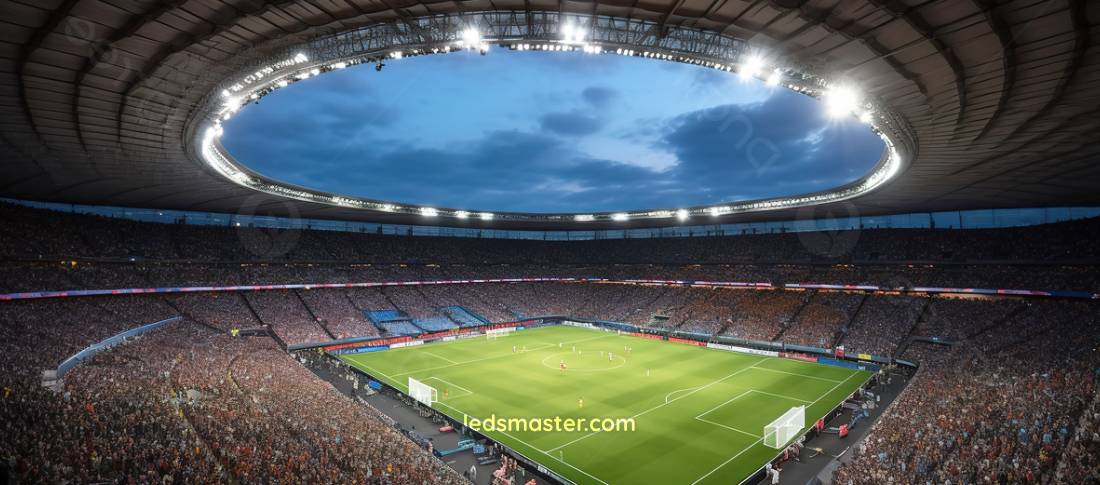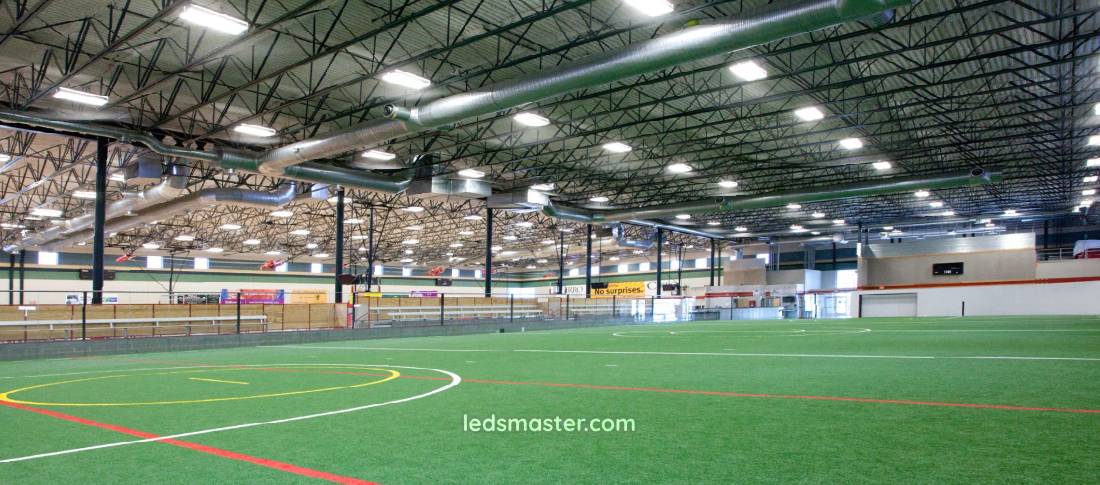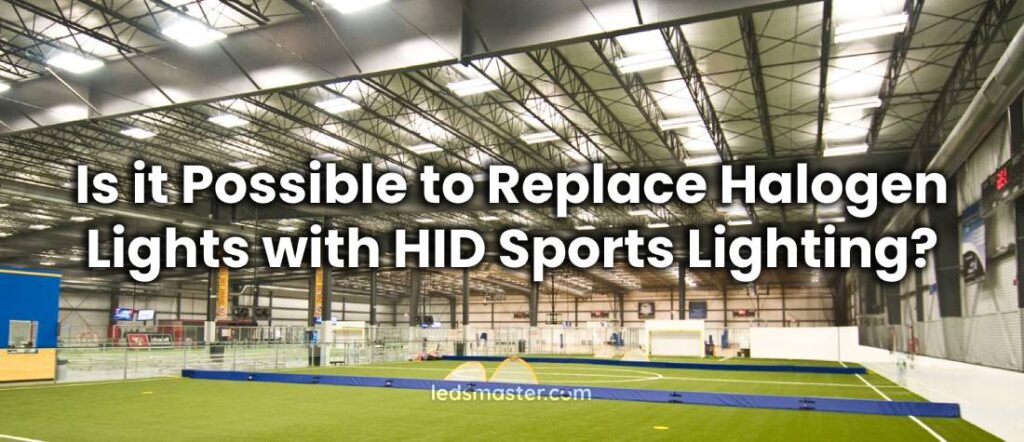When it comes to choosing lighting for sports facilities, two common types of lighting technologies often come up: halogen lights and HID (High-Intensity Discharge) sports lighting. These two options are used in a variety of settings, ranging from outdoor sports fields to indoor arenas, and they offer distinct advantages and drawbacks depending on the specific needs of the environment. Both technologies provide bright illumination, but they do so in different ways, and understanding their differences in cost, usage, and design can help determine which is best for a given application.
Table of Contents
ToggleCost Comparison
| Cost Factor | Halogen Lights | HID Sports Lighting |
|---|---|---|
| Initial Cost per Bulb | $10 – $50 | $100 – $500 |
| Installation Cost per Fixture | $50 – $100 | $150 – $500 |
| Wattage per Fixture | 500 – 1,000 watts | 1,000 – 2,000 watts |
| Energy Consumption (per hour) | 500 – 1,000 watts | 1,500 watts (average) |
| Energy Cost per Hour (1,000W) | $0.12 – $0.15 per kWh | $0.12 – $0.15 per kWh (for 1,500W) |
| Monthly Energy Cost (30 Days) | $28 – $36 | $20 – $25 |
| Lifespan of Bulb | 2,000 – 4,000 hours | 15,000 – 20,000 hours |
| Bulb Replacement Cost | $10 – $30 per bulb | $150 per bulb |
| Annual Energy & Maintenance Cost per Fixture | $600 – $1,000 (includes energy & bulb replacements) | $400 – $450 (includes energy & bulb replacements) |
| Annual Savings (per Fixture) | – | $150 – $600 savings over halogen |
Halogen Lights and Their Cost
Halogen lights are widely regarded as a more affordable lighting option in terms of initial investment. The cost of a halogen bulb typically ranges from $10 to $50, depending on its wattage and the manufacturer. When it comes to installation, the cost for setting up halogen lighting systems can be relatively low, ranging from $50 to $100 per fixture, which is influenced by the complexity of the installation and the necessary infrastructure. This lower cost makes halogen lighting attractive for smaller venues or areas that operate under budget constraints.
However, halogen lights are less efficient than newer lighting technologies. A typical halogen bulb consumes anywhere between 500 to 1,000 watts per bulb. For instance, a 1,000-watt halogen light may cost about $0.12 to $0.15 per kilowatt-hour (kWh) to operate. If the light is used for 8 hours a day over 30 days, the monthly energy cost could range from $28 to $36.
The lifespan of halogen lights is another drawback. On average, these bulbs last between 2,000 to 4,000 hours, which leads to frequent replacements and increased operational costs. The replacement cost for halogen bulbs typically falls between $10 and $30. Additionally, the excessive heat generated by halogen lamps adds strain to air conditioning systems in large venues, which further increases operational expenses.
HID Sports Lighting and Its Cost

HID sports lighting, which includes technologies like Metal Halide and High-Pressure Sodium lamps, involves a higher upfront cost but tends to offer greater long-term value. The cost of a high-quality HID lamp generally ranges from $100 to $500 per bulb, depending on the specific wattage and technology used, with fixtures typically ranging from 1,000 watts to 2,000 watts. The installation costs for HID systems can be significantly higher, ranging from $150 to $500 per fixture. This price reflects the need for additional components, such as ballasts, specialized wiring, and mounting systems. For larger sports fields or stadiums, a full HID lighting system can easily exceed $50,000 to $100,000 when considering the necessary infrastructure and installation labor.
Despite the higher initial costs, HID lighting systems are much more energy-efficient than halogen bulbs. A 1,500-watt Metal Halide bulb, for example, consumes about 1.5 kWh per hour. In comparison to halogen lighting, HID lamps consume 30% to 50% less power while providing similar light output. For instance, operating a 1,500-watt HID lamp for 8 hours a day for 30 days could cost around $20 to $25, saving approximately $10 to $12 compared to an equivalent halogen system.
In terms of longevity, HID lights also outperform halogen bulbs. HID bulbs typically last between 15,000 to 20,000 hours, which is 3 to 5 times longer than halogen bulbs. This longer lifespan means that HID lighting systems require fewer replacements over time, reducing maintenance and operational costs. For example, a 1,500-watt HID bulb may cost $150 to replace, but it typically needs to be replaced only once every 2 to 3 years, assuming 8 hours of daily usage.
Another benefit of HID lighting is the significant reduction in maintenance labor and downtime, especially in large sports venues. Given their longevity and efficiency, HID lights minimize the frequency of replacements and offer more reliable lighting for sports events.
Long-Term Cost Savings
Over time, the long-term operational costs of halogen and HID lighting systems diverge significantly. Assuming both types of lighting are used for 8 hours per day and 30 days per month, the following breakdown of energy and maintenance costs for each system highlights the difference:
For halogen lights, the energy costs per bulb range from $28 to $36 per month. Maintenance and bulb replacement costs add $10 to $30 for every 2,000 to 4,000 hours of use. The total annual cost per fixture, including energy and replacement bulbs, ranges from $600 to $1,000.
In comparison, HID lights are more efficient. Energy costs per bulb range from $20 to $25 per month, and maintenance and bulb replacement costs average $150 for every 15,000 to 20,000 hours. The total annual cost per fixture, factoring in both energy consumption and replacements, ranges from $400 to $450.
Although the initial installation cost for HID systems is higher, the savings in energy and maintenance costs over time make them more cost-effective, particularly when used in large sports venues. The annual savings per fixture can range from $150 to $600, depending on the scale of the installation and the intensity of use.
Usage and Performance

Halogen Lights for Sports Facilities
Halogen lights, while offering high light output and good color rendering, are not typically the first choice for large-scale sports lighting. Their brightness can be adequate for smaller venues or for activities that don’t demand high levels of illumination. However, halogen lights fall short in larger sports arenas or outdoor stadiums where the demand for brightness and uniform light distribution is much greater.
The usage of halogen lighting in sports venues is more common in environments like practice fields or small stadiums where the scale of the lighting system can be controlled more easily. Halogen lights are capable of providing instant illumination, which can be useful for applications where quick lighting is needed. However, they also take up more energy to produce comparable light output when compared to more modern lighting systems, which makes them less efficient for long-term usage.
Another downside is that halogen lights have a relatively short lifespan. Frequent bulb replacements are often required, especially in areas where the lights are in use for extended periods, which can increase maintenance costs. Additionally, halogen lights produce significant amounts of heat, which may not be ideal for certain environments where excess heat is a concern.
HID Sports Lighting for Large Venues
HID sports lighting is designed specifically for large-scale, high-intensity applications. These lights are often used in stadiums, arenas, and large outdoor sports fields due to their ability to produce bright, uniform lighting over a wide area. HID lamps, particularly Metal Halide lamps, are known for their ability to provide a high lumen output while being relatively energy-efficient compared to older lighting technologies.
One of the most notable advantages of HID lighting is its ability to maintain consistent light levels over extended periods. HID lights take a little longer to reach full brightness compared to halogen lights, but once they are on, they provide stable and powerful illumination. Additionally, HID lights are available in a variety of configurations to meet the specific lighting needs of a facility, including options that are well-suited for broadcasting or other specialized applications.
While the initial investment for HID sports lighting is higher, the long-term benefits of better energy efficiency, lower maintenance costs, and higher-quality illumination make them more suitable for large sports venues. The lighting system can be tailored to provide the precise amount of light needed, which is crucial for ensuring visibility and safety in sports events.
Design Considerations
Halogen Lights: Simplicity and Compactness
Halogen lights are known for their simplicity and compact design, which makes them versatile for smaller applications. These lights are typically available in a variety of bulb sizes, and they are compatible with a wide range of fixtures and electrical setups. The compact size of halogen lamps means that they can be installed in a variety of spaces, even in locations with limited room for bulky fixtures.
In terms of design, halogen lights do not require complex support structures or cooling systems, which keeps their design relatively simple and easy to implement. For smaller sports venues or areas with less stringent lighting requirements, the design of halogen lights can be adequate, offering flexibility and ease of installation.
However, for larger facilities, halogen lights may not provide the necessary light distribution. The light produced by halogen bulbs tends to be more focused, which may result in uneven lighting and shadows in large spaces. To achieve uniform light distribution in a stadium, numerous fixtures would need to be installed, leading to higher costs and a more cluttered setup.
HID Sports Lighting: Advanced Technology and Customization
HID sports lighting, by contrast, is specifically designed to meet the complex lighting needs of large venues. These systems are highly customizable and can be configured to provide the precise lighting patterns and intensities needed for different types of events. HID lights can be installed with advanced reflector systems and lenses that ensure a wide and uniform light distribution across the entire field or court. This ensures that there are no dark spots, providing better visibility for players and spectators alike.
HID systems can be more elaborate than halogen systems, often requiring more substantial mounting and support structures. The complexity of HID sports lighting designs can also include advanced cooling systems, as the high-intensity lamps generate a significant amount of heat. As a result, the design and installation of HID sports lighting systems can be more intricate and expensive than halogen lighting setups. However, these advanced systems provide more flexibility and performance benefits, especially in large-scale applications.
The versatility of HID sports lighting also extends to its ability to support various features, such as dimming capabilities, color temperature control, and compatibility with broadcasting technologies. These added features make HID lighting an appealing choice for high-profile sports events, as they can be adjusted to meet specific broadcast standards or event requirements.
Can Halogen Lights Replace HID Sports Lighting?
While halogen lights are a more affordable lighting option initially, they are not a practical long-term solution for replacing HID sports lighting, especially in large venues or areas where high-quality illumination is critical. The fundamental differences in energy efficiency, lifespan, and lighting output make halogen lights less suitable for sports lighting, particularly for facilities requiring consistent and high-intensity lighting for extended periods.
Limitations of Halogen Lights in Replacing HID Sports Lighting
While halogen lights offer some advantages in smaller-scale applications, they are generally not suited for replacing HID sports lighting, particularly in larger sports venues. The primary reason for this is the difference in light output and energy efficiency. Halogen lights tend to consume more power to produce the same amount of light as HID lamps, which makes them less efficient for large-scale use. This results in higher operational costs over time, particularly in venues where lights are in use for long durations.
Additionally, the short lifespan of halogen bulbs means that they need to be replaced more frequently than HID bulbs. This creates ongoing maintenance costs and potential disruptions in lighting availability during replacement periods. For larger venues, this frequent maintenance requirement is not practical, and the higher costs associated with maintaining a halogen lighting system could outweigh the initial savings from the lower upfront cost.
Another factor to consider is the quality and distribution of light. Halogen lights, due to their more focused light output, may not provide the level of uniformity needed for high-performance sports lighting. In contrast, HID sports lighting systems are designed specifically to provide even, broad coverage, which is crucial for ensuring optimal visibility across an entire sports field or arena.
Situations Where Halogen Lights Remain a Practical Choice
Despite the limitations of halogen lights for large sports venues, they could still be considered in certain scenarios where the scale and intensity of lighting are not as demanding. For example, practice fields, smaller recreational areas, or venues with limited lighting needs may still benefit from halogen lighting. In such environments, the cost savings in installation and maintenance could outweigh the drawbacks in energy efficiency and lifespan.
Moreover, if the sports venue does not host major events or require the level of illumination needed for professional broadcasting, halogen lighting could suffice for providing general visibility. In these cases, halogen lights might be chosen for their low upfront cost and the ease with which they can be installed.
Conclusion
While halogen lights offer a lower initial cost and are suitable for smaller applications, they are not a practical long-term solution for replacing HID sports lighting, particularly in large venues. The main reasons for this are the significant differences in energy efficiency, lifespan, and lighting quality. Halogen lights are less energy-efficient, require more frequent bulb replacements, and fail to provide the even and intense illumination needed for large-scale sports venues. These limitations make them a less viable option when compared to HID lighting systems.
HID sports lighting, although initially more expensive to install, offers substantial long-term savings through reduced energy consumption and lower maintenance costs. Its ability to provide consistent, high-quality illumination across large areas, combined with a longer lifespan and better energy efficiency, makes it the preferred choice for professional sports facilities. HID lights are designed to meet the complex lighting demands of large stadiums, arenas, and outdoor fields, ensuring optimal visibility and performance for athletes and spectators alike.
Ultimately, for large sports venues that require reliable, cost-effective, and high-performance lighting, HID sports lighting remains the superior option. While halogen lights may still have their place in smaller venues or for less demanding applications, HID systems offer the necessary benefits that make them the most suitable choice for large-scale sports lighting.

